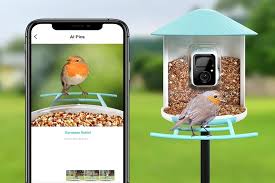Backyard birdwatching has long been a relaxing and rewarding hobby — a chance to connect with nature, learn about wildlife, and observe feathered visitors up close. But now, thanks to the rise of smart home technology, even bird feeders are getting a high-tech upgrade. Smart bird feeders are revolutionizing how people experience birdwatching, combining artificial intelligence, HD video, and app connectivity to create an entirely new kind of wildlife interaction.
In this article, we’ll explore how smart bird feeders work, why they’re gaining popularity, and how they’re changing the way we observe and enjoy birds — whether you’re a casual backyard birder or a lifelong enthusiast.
What Is a Smart Bird Feeder?
A smart bird feeder is a next-generation bird feeder equipped with modern features like motion-activated HD cameras, species recognition powered by artificial intelligence, and wireless connectivity through mobile apps. These feeders can automatically take photos and videos of bird visitors, notify you in real time when a bird lands, and even identify the species using trained AI models.
Unlike traditional feeders, which require manual observation, smart bird feeders offer passive, always-on birdwatching — making them ideal for busy homeowners, tech lovers, and birders of all experience levels.
Top Features That Make Smart Feeders “Smart”
Most high-end smart feeders come with a powerful set of built-in features:
- HD Camera with Night Vision – Capture crystal-clear photos and videos, day or night.
- AI Bird Identification – Automatically detect and label bird species using image recognition.
- Mobile App Alerts – Get notifications when a bird visits and view live footage from anywhere.
- Cloud Storage – Store your sightings safely for review, sharing, or data analysis.
- Squirrel Detection – Some feeders can detect and deter squirrels and other non-bird visitors.
- Weather-Resistant Design – Built to withstand outdoor conditions year-round.
- Solar Charging – Many models now come with solar panels for off-grid operation.
These features work together to provide a seamless birdwatching experience, offering more insight and interaction than ever before.
Why Birders Love Them — From Beginners to Pros
Whether you’re just starting out or have decades of experience, smart bird feeders offer unique benefits:
- For casual birdwatchers:
- No more guessing which bird you just saw — the app tells you instantly.
- Automatically captures every visit, even when you’re not home.
- Easy to use, fun for kids, and shareable on social media.
- For serious enthusiasts and researchers:
- Long-term bird visit tracking with timestamps and visual records.
- Reliable data collection for seasonal trends and migration patterns.
- Seamless integration with birding platforms like Cornell’s Merlin Bird ID.
This blend of convenience and data makes smart feeders a game-changer for anyone interested in birds, nature, or backyard ecology.
How AI Is Reshaping Bird Identification
One of the most exciting features of smart bird feeders is their use of artificial intelligence to identify bird species in real time. These systems are trained on massive datasets of bird images and can recognize thousands of species with impressive accuracy.
Some feeders use built-in models, while others tap into larger databases through connected apps. This capability transforms your feeder into an always-on wildlife researcher — offering instant IDs, behavior notes, and species details with just a tap.
The best part? You don’t need to be a bird expert. The technology does the work for you, helping you learn more with every visit.
A Smarter Way to Engage With Nature
Smart bird feeders don’t just record birds — they create a new kind of interaction. You can:
- View live footage of a feeding cardinal while on vacation
- Get notified when a rare species visits
- Automatically save and catalog your sightings over weeks or months
It’s a way to stay connected to your backyard ecosystem, even when life gets busy. And for families, it turns passive backyard time into an engaging, educational experience for kids and adults alike.
Common Concerns and Considerations
Like any tech product, smart bird feeders come with a few trade-offs:
- Cost – Expect to pay anywhere from $100 to $300 depending on features.
- Wi-Fi Dependence – You’ll need strong outdoor Wi-Fi for live streaming and alerts.
- Privacy – These devices contain cameras; make sure to position them responsibly.
- App Usability – Not all companion apps are created equal — some are buggy or limited.
Still, as the technology matures and more models enter the market, these concerns are gradually being addressed — and the overall experience continues to improve.
The Future of Birdwatching Is Here
The rapid adoption of smart feeders signals a broader trend: wildlife watching is going digital. In the coming years, we may see:
- Community-connected feeders that share data with neighbors or scientists
- Voice notifications through smart speakers when birds visit
- Augmented reality overlays that display bird facts on live video
- AI learning loops where feeders get smarter as you use them
This innovation is creating a more immersive, informative, and accessible birding experience — one that anyone can enjoy, regardless of location or experience level.
Looking to Get Started?
If you’re ready to bring your birdwatching into the modern age, check out this expert guide to the year’s best models:
👉 Best Smart Bird Feeders for 2025 – Ranked by Features, Price & Performance
Whether you’re looking for top-tier AI recognition or a budget-friendly camera setup, there’s a smart bird feeder out there that’s perfect for your backyard.





























